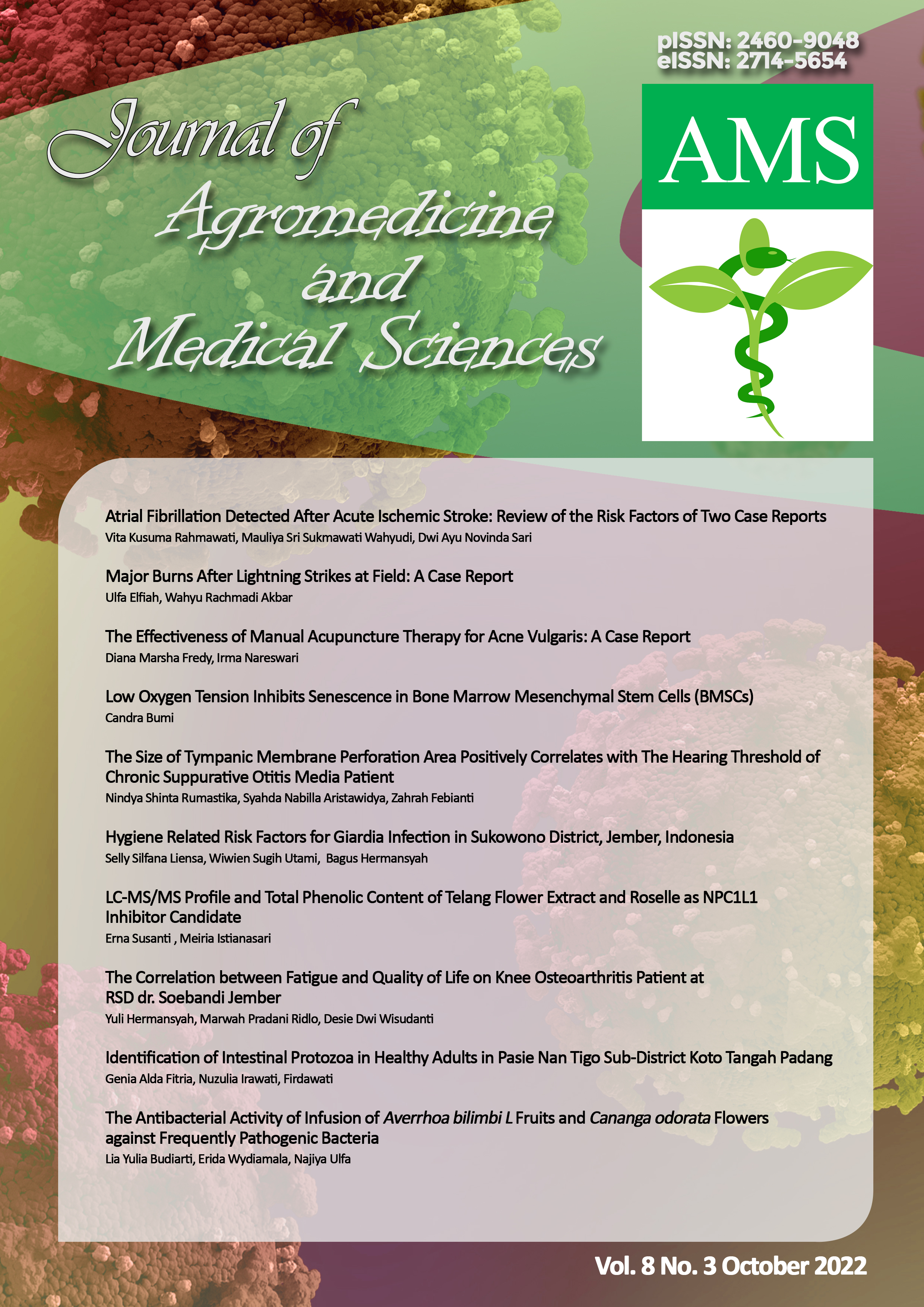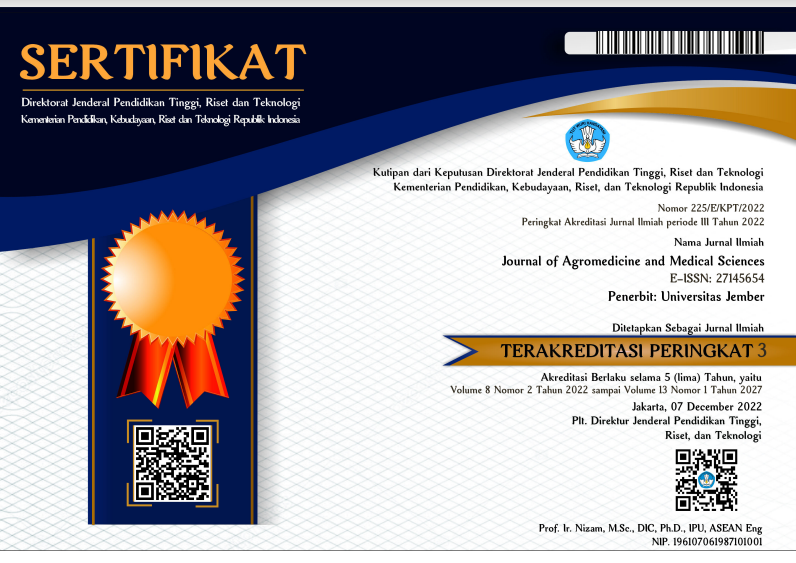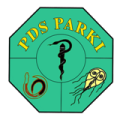The Antibacterial Activity of Infusion of Averrhoa bilimbi L Fruits and Cananga odorata Flowers against Frequently Pathogenic Bacteria
DOI:
https://doi.org/10.19184/ams.v8i3.29312Abstract
Infectious diseases due to opportunistic bacteria and pathogens are still a health problem. Transmission can be prevented by using an alcohol-based antiseptic liquid or naturally. Averrhoa bilimbi L. fruit plants and Cananga odorata flowers contain bioactive compounds that can inhibit bacterial growth. This study aimed to analyze the infusion activity of Averrhoa bilimbi fruit and Cananga odorata flower in single and combined dosage forms against several frequently pathogenic bacteria in vitro. This posttest-only experimental study with a control group design used the paper disc diffusion method. Observation parameters were the diameter of the inhibition zone on the test bacteria after infusion treatment of 50%, 75%, and 100% A.bilimbi fruit and 100% C.odora flowers, as well as 70% alcohol. The results showed that the diameter of the inhibition zone in the combination treatment of A.bilimbi and C.odorata infusion was significantly different from that of the single preparation (p<0.05). The combination of 100% A.bilimbi and 100% C.odorata (ratio 1:1) produced the greatest effect and was equivalent to 70% alcohol. The average inhibition of the combination infusion of Staphylococcus aureus (17.36mm) and Staphylococcus epidermidis (17.57mm) was greater than that of Escherichia coli (14.48 mm) and Salmonella enterica serovar Typhi (14.12mm). In conclusion, the infusion of Averrhoa bilimbi fruit and the Cananga odorata flower had antibacterial activity, and the combined preparation produced a better inhibitory effect than the single preparation.
Keywords: antibacterial activity, Averrhoa bilimbi L., Cananga odorata, infusion, single preparation, combination preparation
Downloads
References
Achwandi, M., & Khoiriyati, A. (2015). Efektivitas Ekstrak Daun Sirih Merah (Piper Crocatum) Terhadap Kadar Hambat Minimum Dan Kadar Bunuh Minimum Bakteri Salmonella typhi. Indonesian Journal Pf Nursing Practices, 2(1), 1–8.
Akib, N. I., Wulandari, I. W., Suryani, S., & Hanari, H. (2019). FORMULASI GEL HAND SANITIZER ANTIBAKTERI KOMBINASI EKSTRAK RUMPUT LAUT Eucheuma spinosum DAN Eucheuma cotonii ASAL KEPULAUAN WAKATOBI SULAWESI TENGGARA. Jurnal Fish Protech, 2(2), 180. https://doi.org/10.33772/jfp.v2i2.9232
Alhassan, A., & Ahmed, Q. (2016). Averrhoa bilimbi Linn.: A review of its ethnomedicinal uses, phytochemistry, and pharmacology. In Journal of Pharmacy and Bioallied Sciences (Vol. 8, Issue 4, pp. 265–271). Wolters Kluwer -- Medknow Publications. https://doi.org/10.4103/0975-7406.199342
Anggia, M., Mutiar, S., & Arziah, D. (2018). Teknologi Ekstraksi Bunga Kenanga (Cananga Odorata L.) dan Sereh Wangi (Cymbopogon Nardus L. ) Sebagai Aroma Terapi Sabun Cair. Jurnal Daur Lingkungan, 1(1), 5. https://doi.org/10.33087/daurling.v1i1.2
Arisanty, A., & Dewi, R. P. (2018). UJI EFEKTIVITAS EKSTRAK AIR BUAH BELIMBING WULUH (Averrhoa bilimbi) TERHADAP PERTUMBUHAN Propionibacterium acnes. Media Farmasi, 14(2), 66. https://doi.org/10.32382/mf.v14i2.601
Asngad, A., R, A. B., & Nopitasari, N. (2018). Kualitas Gel Pembersih Tangan (Handsanitizer) dari Ekstrak Batang Pisang dengan Penambahan Alkohol, Triklosan dan Gliserin yang Berbeda Dosisnya. Bioeksperimen: Jurnal Penelitian Biologi, 4(2), 61–70. https://doi.org/10.23917/bioeksperimen.v4i2.6888
Broniatowski, M., Mastalerz, P., & Flasiński, M. (2015). Studies of the interactions of ursane-type bioactive terpenes with the model of Escherichia coli inner membrane - Langmuir monolayer approach. Biochimica et Biophysica Acta - Biomembranes, 1848(2), 469–476. https://doi.org/10.1016/j.bbamem.2014.10.024
Budiarti, L. Y., Isnaini, I., Dayana, P., Sari, N., & S., N. A. R. (2021). Antimicrobial Activity of Stenochlaena palustris and Sauropus androgynus in Staphylococcus aureus, Escherichia coli and Candidia albicans. Bioinformatics and Biomedical Research Journal, 4(1), 32–38. https://doi.org/10.11594/bbrj.04.01.05
Budiarti, L. Y., Khariyati, L., & Fakhriyadi, R. (2017). The Relationship Between The Existence of Bacterial Type From Hand and Feces with Water Piping on Elementary School Students on The Riverbanks of Kuin in Banjarmasin. Proceding International Seminar : Development of Tropical Disease Research Based on Wetland and Indonesian Local, 336–347.
Budiarti, L. Y., Wydiamala, E., & Ulfa, N. (2021). Phenol Coefficient Test Combination Infusion of Cananga odorata – Averrhoa bilimbi L. Against Staphylococcus aureus and Salmonella typhi in Vitro. Bioinformatics and Biomedical Research Journal, 4(1), 19–26. https://doi.org/https://doi.org/10.11594/bbrj.04.01.03
Budiarti, L. Y., Yasmina, A., Nurikwan, P. W., Prayudi, M. O. S., Firisa, M. R., & Kangsudarmanto, Y. (2022). Antibacterial activity of infused peel of kaffir lime, manurun banana, and pineapple against the number of Staphylococcus aureus and Escherichia coli colonies. IOP Conference Series: Earth and Environmental Science, 976(1), 012034. https://doi.org/10.1088/1755-1315/976/1/012034
Carvalho, R. S., Carollo, C. A., de Magalhães, J. C., Palumbo, J. M. C., Boaretto, A. G., Nunes e Sá, I. C., Ferraz, A. C., Lima, W. G., de Siqueira, J. M., & Ferreira, J. M. S. (2018). Antibacterial and antifungal activities of phenolic compound-enriched ethyl acetate fraction from Cochlospermum regium (mart. Et. Schr.) Pilger roots: Mechanisms of action and synergism with tannin and gallic acid. South African Journal of Botany, 114, 181–187. https://doi.org/10.1016/j.sajb.2017.11.010
Davis, W. W., & Stout, T. R. (1971). Disc Plate Method of Microbiological Antibiotic Assay. Applied Microbiology, 22(4), 666–670. https://doi.org/10.1128/am.22.4.666-670.1971
Dewi, P., Ratih, G. A., Burhannuddin, B., & Sudarmanto, G. (2019). In vitro Inhibitory Activity of Ethanolic Fruit Extract from Averrhoa bilimbi L. against Streptococcus pyogenes Bacteria. Health Notions, 3(1), 13–17. https://doi.org/10.33846/hn.v3i1.276
Dusturia, N., S.R. Hikamah, D. S. (2016). Efektivitas Antibakteri Bunga Kenanga (Cananga odorata) dengan Metode Konvensional terhadap Pertumbuhan Staphylococcus aureus. Bioshe. J Bioshell, 5(01), 324–332.
Fardan, I., & Harimurti, S. (2018). Formulasi Sediaan Gel Minyak Atsiri Daun Cengkeh (Syzygium aromaticum (L.) Merr. & L.M.Perry) Sebagai Antiseptik Tangan dan Uji Daya Hambat Terhadap Bakteri Staphylococcus aureus. PHARMACY: Jurnal Farmasi Indonesia (Pharmaceutical Journal of Indonesia), 15(2), 218. https://doi.org/10.30595/pharmacy.v15i2.3001
Fibonacci, A., & Hulyadi, H. (2018). Uji Aktivitas Antimikroba Daun Sirsak (Annona muricata L.) Terhadap Bacillus subtillis dan Eschericia coli. Walisongo Journal of Chemistry, 1(1), 14. https://doi.org/10.21580/wjc.v2i1.2669
Hardiyanti, R., Budiarti, L. Y., & Heriyani, F. (2019). Perbedaan Jumlah Bakteri Tangan Pada Siswa Sekolah Dasar Di Sekitar Bantaran Sungai Lulut Banjarmasin Berdasarkan Teknik Mencuci Tangan. Jurnal Homeostatis, 2(1), 179–184.
Hasanuzzaman, M., Ali, M. R., Hossain, M., Kuri, S., & Islam, M. S. (2013). Evaluation of total phenolic content, free radical scavenging activity and phytochemical screening of different extracts of Averrhoa bilimbi (fruits). International Current Pharmaceutical Journal, 2(4), 92–96. https://doi.org/10.3329/icpj.v2i4.14058
Heriyani, F., Budiarti, L. Y., Nursantari, W., & Apriliani, A. (2021). Hand Soap Activity Against the Number oOf Bacterial Colonies from the Housewife’s Hand Swab Samples in a Temporary Landfill in Kelurahan Gadang Banjarmasin. Berkala Kedokteran, 17(2), 87. https://doi.org/10.20527/jbk.v17i2.11665
Herlina, E., Widiastuti, D., & Triadi, A. (2020). POTENSI MINYAK ATSIRI BUNGA KENANGA (CANANGA ODORATA) SEBAGAI ANTIBAKTERIA DALAM SEDIAAN HAND SANITIZER GEL. EKOLOGIA, 20(2), 88–94. https://doi.org/10.33751/ekologia.v20i2.2171
Khalid, M., Saeed-ur-Rahman, Bilal, M., & HUANG, D. feng. (2019). Role of flavonoids in plant interactions with the environment and against human pathogens — A review. In Journal of Integrative Agriculture (Vol. 18, Issue 1, pp. 211–230). Elsevier. https://doi.org/10.1016/S2095-3119(19)62555-4
Lisnawati, N., Kumala, S., & Rahmat, D. (2019). Formulation and evaluation of antibacterial activity of nanoparticles ointment preparation using Blimbi extract. Pharmaceutical and Biomedical Research. https://doi.org/10.18502/pbr.v4i3.542
Maryam, S., Juniasti, S., & Kosman, R. (2015). UJI AKTIVITAS ANTIBAKTERI EKSTRAK ETANOL BUAH BELIMBING WULUH (Averrhoa bilimbi L.) ASAL KOTA WATAMPONE. Jurnal Ilmiah As-Syifaa, 7(1), 60–69. https://doi.org/10.33096/jifa.v7i1.21
Maulidya, R., Aisyah, Y., & Yunita, D. (2020). Quality Characteristics and Antibacterial Activity of Transparent Solid Soap with Addition of Cananga Oil (Cananga odorata). 112–118. https://doi.org/10.5220/0009957701120118
Mokhtar, S. I., & Abd Aziz, N. A. (2016). Antimicrobial Properties of Averrhoa bilimbi Extracts at Different Maturity Stages. Journal of Medical Microbiology & Diagnosis, 5(3). https://doi.org/10.4172/2161-0703.1000233
Nasution, R., Azwar, A. I., Helwati, H., & Marianne. (2019). Antibacterial Activities of Perfume: Combination Flower Magnolia alba, Cananga odorata and Mimusops elengi L, Fixed with Pogostemon cablin Oil. Indonesian Journal of Pharmaceutical and Clinical Research, 2(1), 19–23. https://doi.org/10.32734/idjpcr.v2i1.814
Pramiastuti, O., Rejeki, D., & Maghfiroh, I. (2020). Uji Antibakteri Kombinasi Ekstrak Daun Belimbing Wuluh (Averrhoa bilimbi L) Dan Daun Kersen (Muntingia calabura L) Terhadap Staphylococcus aureus. Parapemikir : Jurnal Ilmiah Farmasi, 9(2), 33–41. https://doi.org/10.30591/pjif.v9i2.2026
Prastiyanto, M. E., Wardoyo, F. A., Wilson, W., & Darmawati, S. (2020). Antibacterial Activity of Various Extracts of Averrhoa bilimbi against Multidrug Resistant Bacteria. Biosaintifika: Journal of Biology & Biology Education, 12(2), 163–168. https://doi.org/10.15294/biosaintifika.v12i2.23600
Putri, A. meiysa, Muham, A. oca, Anggraini, S., Maisarmah, S., & Yulis, P. A. R. (2020). ANALISIS KUALITATIF KANDUNGAN BUNGA KENANGA (Cananga odorata) SECARA FITOKIMIA dengan MENGGUNAKAN PELARUT ETANOL. Journal of Research and Education Chemistry, 2(1), 43. https://doi.org/10.25299/jrec.2020.vol2(1).4783
Qolbi, N., & Yuliani, R. (2018). Skrining Aktivitas Antibakteri Ekstrak Etanol 70% Sepuluh Daun Tanaman Terhadap Klebsiella Pneumoniae. Pharmacon: Jurnal Farmasi Indonesia, 15(1), 8–18. https://doi.org/10.23917/PHARMACON.V15I1.6169
Rachmawati, A., Suprihadi, A., & Kusdiyantin, E. (2017). IDENTIFIKASI SENYAWA BIOAKTIF PADA ISOLAT BAKTERI BUAH BELIMBING WULUH (Averrhoa bilimbi L.) SEBAGAI AGENSIA HAYATI Xanthomonas oryzae pv. oryzae. Jurnal Akademika Biologi, 6(3), 1–11. https://doi.org/10.2/JQUERY.MIN.JS
Rahardhian, M. R. R., Murti, B. T., Wigati, D., Suharsanti, R., & Putri, C. N. (2019). Solvent concentration effect on total flavonoid and total phenolic contents of Averrhoa bilimbi leaf extract. Pharmaciana, 9(1), 137. https://doi.org/10.12928/pharmaciana.v9i1.8793
Santoso, A., Suryadarma, I. B., Sumari, S., & Sukarianingsih, D. (2020). Pembuatan Sabun Aroma Teraphi untuk Masyarakat Pedesaan. Jurnal KARINOV, 3(1), 5. https://doi.org/10.17977/um045v3i1p5-9
Seebaluck-Sandoram, R., Lall, N., Fibrich, B., Blom van Staden, A., Saleem, H., & Mahomoodally, M. F. (2019). Antimicrobial, antioxidant and cytotoxic evaluation of two underutilised food plants: Averrhoa bilimbi L. (Oxalidaceae) and Phyllanthus acidus L. Skeels (Phyllanthaceae). Biocatalysis and Agricultural Biotechnology, 18. https://doi.org/10.1016/j.bcab.2019.01.036
Shahat, A. A., & Marzouk, M. S. (2013). Tannins and Related Compounds from Medicinal Plants of Africa. In Medicinal Plant Research in Africa: Pharmacology and Chemistry (pp. 479–555). Elsevier Inc. https://doi.org/10.1016/B978-0-12-405927-6.00013-8
Sugiharto, S. (2020). The potentials of two underutilized acidic fruits (Averrhoa bilimbi l. and phyllanthus acidus l.) as phytobiotics for broiler chickens. Journal of Advanced Veterinary Research, 10(3), 179–185.
Tadtong, S., Suppawat, S., Tintawee, A., Saramas, P., Jareonvong, S., & Hongratanaworakit, T. (2012). Antimicrobial activity of blended essential oil preparation. Natural Product Communications, 7(10), 1401–1404. https://doi.org/10.1177/1934578x1200701041
Tan, L. T. H., Lee, L. H., Yin, W. F., Chan, C. K., Abdul Kadir, H., Chan, K. G., & Goh, B. H. (2015). Traditional uses, phytochemistry, and bioactivities of Cananga odorata (ylang-ylang). In Evidence-based Complementary and Alternative Medicine (Vol. 2015). Hindawi Publishing Corporation. https://doi.org/10.1155/2015/896314
Wahdaningsih, S., Untari, E. K., & Fauziah, Y. (2014). Antibakteri Fraksi n-Heksana Kulit Hylocereus polyrhizus Terhadap Staphylococcus epidermidis dan Propionibacterium acnes. Pharmaceutical Sciences and Research, 1(3), 180–193. https://doi.org/10.7454/psr.v1i3.3490
Wulansari, N. T., & Parut, A. A. (2019). Pengendalian Jumlah Angka Mikroorganisme Pada Tangan Melalui Proses Hand Hygiene. Jurnal Media Sains, 3(1), 7–13. https://jurnal.undhirabali.ac.id/index.php/jms/article/view/694
Zarwinda, I., Adriani, A., Agustina, M., & Negara, W. (2022). Formulasi Sediaan Gel Hand Sanitizer Dari Ekstrak Etanol Daun Belimbing Wuluh ( Averhoa Blimbi L .) Kombinasi Gel Lidah Buaya ( Aloe Vera ) Pendahuluan Covid 19 atau virus corona pertama kali muncul mulut , hidung dan mata . Upaya memutus mata pemerintah. Jurnal Kedokteran Dan Kesehatan, 9(3). https://doi.org/10.32539/JKK.V9I3.18939























